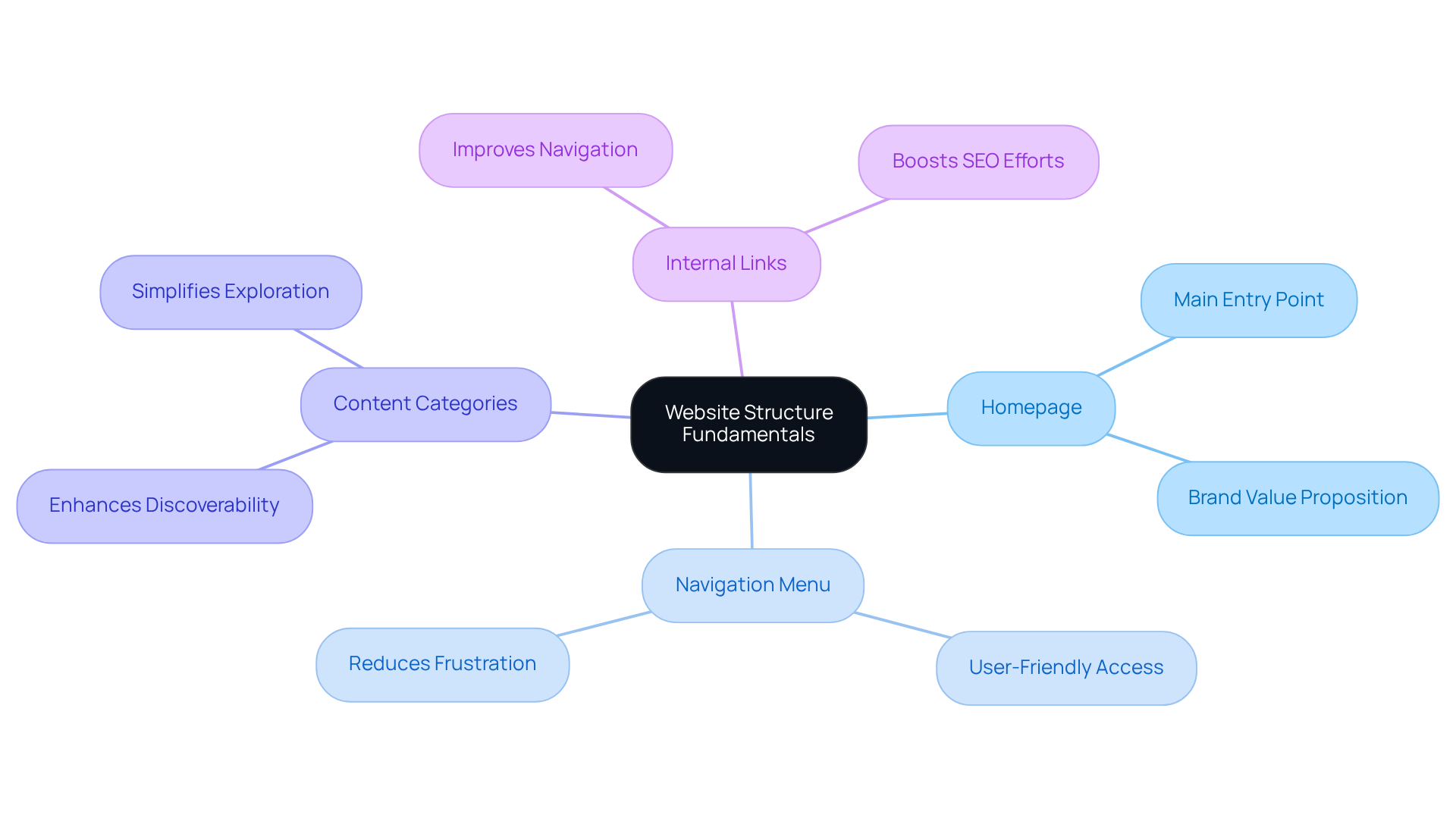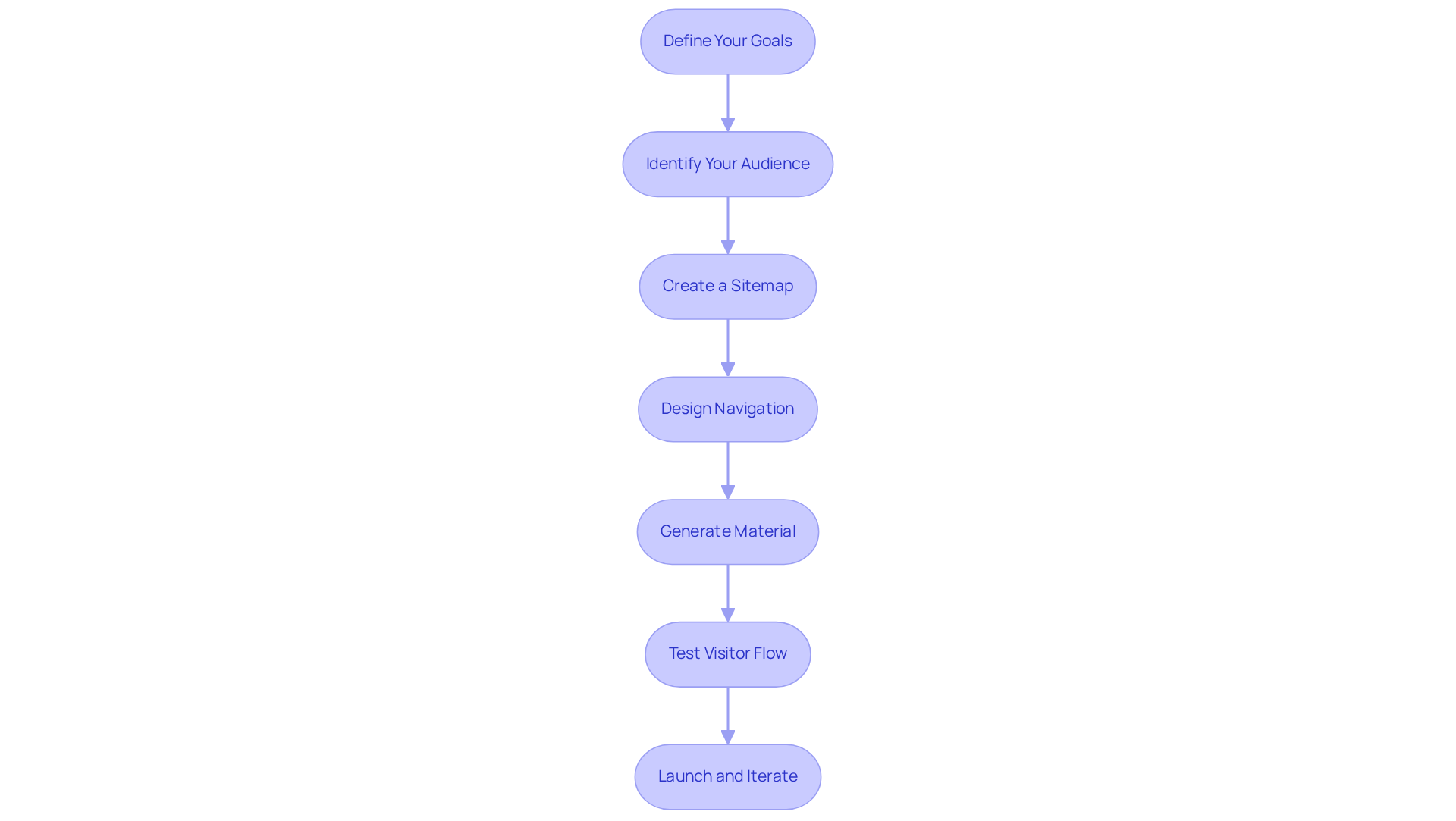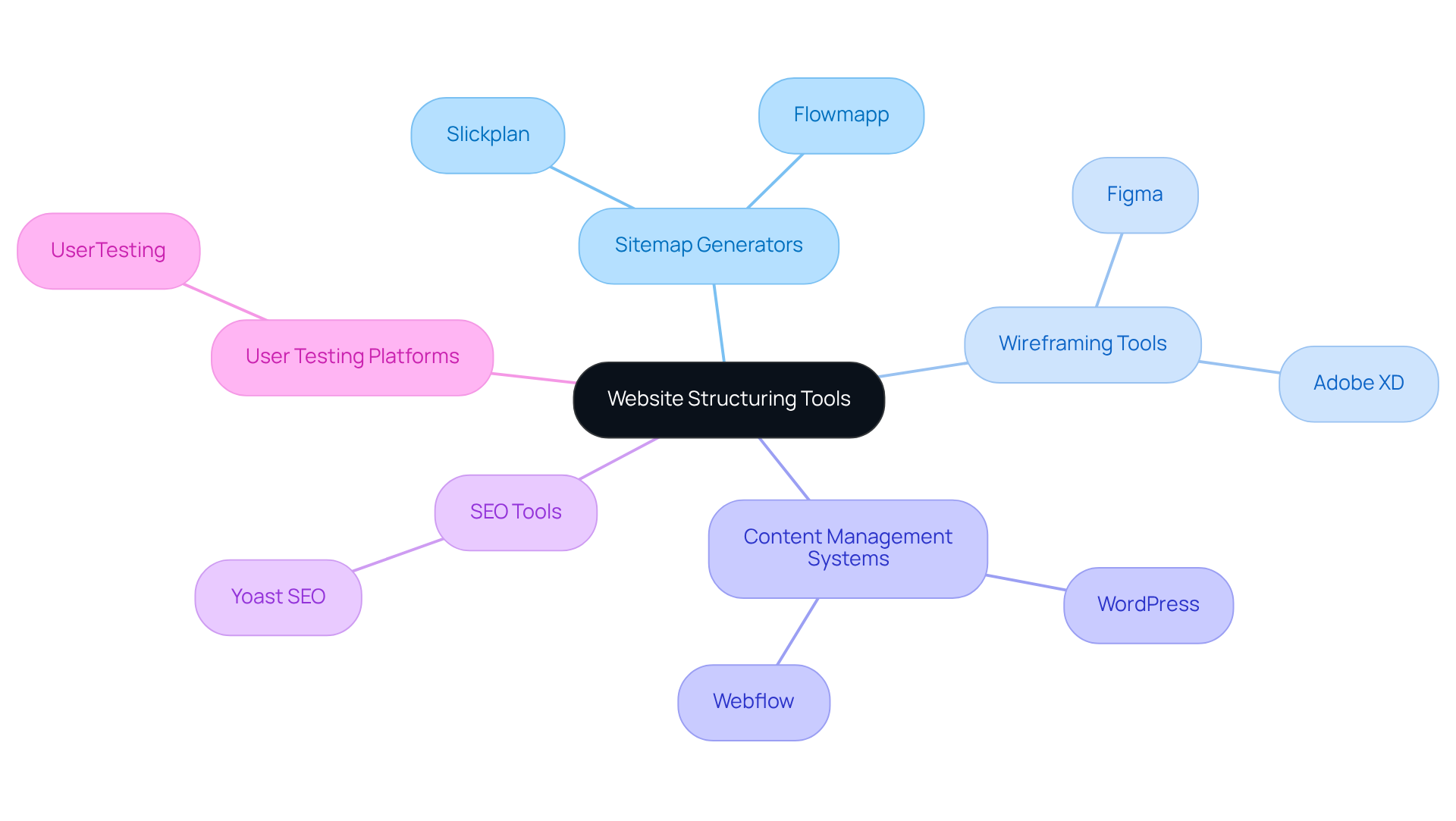Overview
For tech startup founders, structuring a website can often feel overwhelming. You may find yourself asking, 'How do I create a space that truly resonates with my audience?' This uncertainty can lead to frustration and a sense of disconnect from potential users. It's essential to recognize that these feelings are common, and you're not alone in navigating this journey.
The key steps to creating an effective website include:
- Defining your goals
- Understanding your audience
- Creating a sitemap
- Designing intuitive navigation
- Generating engaging content
- Testing visitor flow
- Iterating based on feedback
Each of these steps plays a vital role in not just enhancing user experience and engagement, but also in aligning your website with your overarching business objectives. By following this structured approach, you foster growth and a deeper connection with your users.
Remember, you're building more than just a website; you're crafting an experience that reflects your vision and values. Embrace the process, and allow yourself the space to iterate based on feedback. This journey may be challenging, but with each step, you're moving closer to creating a platform that truly serves your audience and your mission.
Introduction
Crafting an effective online presence can feel overwhelming for many tech startup founders. It's common to grapple with the complexities of website structure, and this challenge can lead to frustration. A well-organized website not only enhances user experience but also serves as a vital tool for achieving your business objectives.
Have you ever wondered if the key to unlocking growth and engagement lies in mastering the essential steps of website structuring? In this article, we will explore the fundamental components, best practices, and common pitfalls to avoid. Together, we will guide you toward creating a seamless digital experience that truly resonates with your audience.
Understand Website Structure Fundamentals
The arrangement and design of a site's pages and information, which is part of structuring a website, is often a source of frustration for many tech startup founders. Visitors may struggle to a website, leading to missed opportunities and a disconnect from the brand's message. This can create a sense of overwhelm, making it difficult for users to find what they need and ultimately hindering business growth.
A well-organized website, however, can transform this experience. Imagine a space where every page flows seamlessly, guiding visitors from one point to another with ease. Key components that contribute to this clarity include:
- Homepage: This is your main entry point, and it should resonate with your audience, clearly communicating your brand's value proposition.
- Navigation Menu: A user-friendly menu is essential; it allows visitors to easily find the information they seek, reducing frustration and enhancing their journey.
- Content Categories: By grouping related content, you enhance discoverability, making it simpler for users to explore what you offer.
- Internal Links: These links connect different pages within your site, improving navigation and boosting your SEO efforts.
Understanding and implementing these elements is crucial for structuring a website that not only meets user needs but also supports your business objectives. At RNO1, we are here to guide you through this process, ensuring that your website becomes a nurturing environment for your visitors, fostering connection and engagement.

Follow a Step-by-Step Process for Structuring Your Website
While structuring a website effectively can feel overwhelming, you’re not alone in this journey. Many tech startup founders grapple with how to create an online presence that truly reflects their vision and meets their audience's needs. Let’s explore some essential steps for structuring a website that will help you navigate this process with confidence.
- Define Your Goals: Start by clearly articulating what you want your website to achieve. Whether your aim is lead generation or enhancing brand awareness, this foundational step will guide all your subsequent decisions. By having a clear vision, you can align your efforts more effectively.
- Identify Your Audience: Understanding your is crucial. Take the time to conduct research and discover their needs and preferences. This insight will inform your design and content strategy, ensuring that your site resonates with them. UX designers emphasize that when your site aligns with audience expectations, engagement improves significantly.
- Create a Sitemap: Visualize your site's structure by structuring a website with a sitemap that outlines the main pages and their hierarchy. Think of this sitemap as your roadmap for structuring a website—ensuring a logical flow of information that helps visitors find what they’re looking for easily.
- Design Navigation: Structuring a website includes designing navigation by crafting a clear and intuitive menu that mirrors your sitemap. Effective navigation is vital for structuring a website; studies show that 61% of individuals expect to locate what they need within five seconds of arriving on a site. Structuring a website with a well-organized menu can significantly reduce bounce rates, which typically range between 41% and 55% across websites.
- Generate Material: Create engaging content for each section, ensuring it meets audience requirements and aligns with SEO best practices. Captivating material not only draws visitors in but also encourages them to stay longer. For instance, Majestic Wine experienced a remarkable 201% rise in inquiry form submissions after revamping their category page, illustrating the profound impact of effective content and design.
- Test Visitor Flow: Conduct usability testing to evaluate how easily individuals can navigate your site. This step is essential; research indicates that 88% of online visitors won’t return after a negative experience, highlighting the importance of a smooth visitor journey.
- Launch and Iterate: Once your site is live, gather feedback from visitors to identify areas for improvement. Continuous refinement, driven by visitor insights, can enhance the overall framework and efficiency of your online platform. Moreover, mobile-optimized sites enjoy 40% higher conversion rates, underscoring the necessity of catering to mobile audiences.
By following these steps for structuring a website, you can create an online platform that not only meets your business objectives but also provides a positive experience for your visitors. Remember, you’re not just launching a website; you’re cultivating a space for connection and engagement that can lead to lasting success.

Utilize Tools and Resources for Effective Website Structuring
For tech startup founders navigating the complexities of online presence, structuring a website can often feel overwhelming. It’s crucial to have the right tools at your disposal to alleviate this burden and ensure a smooth process.
Consider the challenge of structuring a website's architecture. Sitemap generators, like Slickplan and Flowmapp, can be invaluable allies in this journey. They create visual sitemaps that clearly outline your site’s structure, ensuring that all essential sections are included and logically arranged. This organization is vital not only for structuring a website to improve user navigation but also for . In 2025, many startups have found these tools essential in their early development stages, recognizing their role in laying a solid foundation.
Next, think about the layout of your pages. Wireframing tools such as Figma and Adobe XD allow you to design before diving into development. These platforms foster collaboration and refinement, helping teams visualize user flows and interface components effectively. As a web design expert once shared, "Figma and Adobe XD are essential for startups looking to create intuitive designs that resonate with users." This insight underscores the importance of thoughtful design in connecting with your audience.
Content management systems (CMS) like WordPress and Webflow also play a critical role. They provide templates and features that simplify the organization and management of your information. By streamlining the process of structuring a website and refreshing your online content, these platforms empower startups to maintain a professional digital presence.
Moreover, SEO tools like Yoast SEO are indispensable for optimizing your site’s structure for search engines. By ensuring your site is search-engine friendly, you can enhance visibility and attract more organic traffic, which is essential for growth.
Finally, user testing platforms such as UserTesting offer invaluable insights into your site’s usability. By gathering feedback from real users, you can refine your framework and elevate the overall experience, ensuring your site meets the needs of your audience.
By leveraging these supportive tools, tech startups can build a solid foundation for their online presence, fostering better engagement and growth. Remember, you’re not alone in this journey; many others have walked this path and found success with the right resources.

Troubleshoot Common Website Structuring Issues
Common problems in structuring a website can significantly affect visitor experience and retention, and it’s important to recognize how these issues can impact your journey as a tech startup founder. Let’s explore some key areas to address, so you can create a more welcoming online space for your users.
- Poor Navigation: Imagine a visitor struggling to find the information they need. It can be frustrating, right? Simplifying your menu and ensuring that all important pages are easily accessible can enhance usability. A well-structured navigation system can lead to a remarkable increase in conversion rates—up to 400%. This highlights just how crucial it is to . As someone once said, "a well-thought-out, frictionless UX design could potentially raise conversion rates up to 400%.”
- Broken Links: Have you ever encountered a broken link? It’s disheartening for visitors and can negatively impact your SEO. Regularly checking for and fixing these links is essential. A study found that 91% of unhappy customers leave without providing feedback, often due to such issues. Bill Gates wisely noted, "Your most unhappy clients are your greatest source of learning," reminding us to tackle customer dissatisfaction proactively. Implementing a systematic approach to link management can help you avoid these pitfalls.
- Inconsistent Layouts: Think about how comforting it is to navigate a site that feels familiar. Uniformity throughout your sections promotes confidence. Ensure that design elements, such as fonts and colors, are consistent across the site to create a cohesive experience.
- Overly Complex Hierarchies: Picture a visitor overwhelmed by deep nesting of pages. It’s best to aim for a flat structure where most pages are accessible within just 1-2 clicks from the homepage. This approach not only enhances navigation but also boosts satisfaction; in fact, 88% of individuals are less likely to return after a negative experience.
- Lack of Mobile Optimization: With over half of global web traffic coming from mobile devices, it’s crucial to ensure your online platform is responsive and functions well on smartphones. A mobile-compatible design can greatly enhance interaction, as mobile visitors are five times more prone to leaving a task if the platform isn’t optimized for mobile. A positive mobile experience can lead to a 74% increase in the likelihood of users revisiting your site.
By proactively addressing these common issues, you can improve the structuring of a website to create a more effective and user-friendly platform that fosters better engagement and retention. Remember, it’s about creating a space where your users feel valued and understood.

Conclusion
For tech startups, a well-structured website is more than just a digital space; it's a vital foundation for building a strong online presence and nurturing meaningful connections with your audience. Many founders face the daunting challenge of creating an engaging environment that not only draws in visitors but also encourages them to delve deeper and ultimately become loyal customers.
In this guide, we've explored essential steps to help you structure your website effectively. From defining your goals and understanding your target audience to creating a sitemap and designing intuitive navigation, each step is crucial. We've highlighted the importance of quality content, usability testing, and the ongoing refinement of your website to enhance the user experience. Remember, utilizing tools like sitemap generators, wireframing tools, and content management systems can significantly ease this process, leading to a polished final product.
The importance of a well-structured website truly cannot be overstated. It acts as a critical touchpoint for potential clients and customers, shaping their perception of your brand. By addressing common issues such as poor navigation, broken links, and the absence of mobile optimization, you can create a user-friendly platform that meets your business objectives while fostering lasting relationships with your visitors. Embracing these practices will not only support your startup's growth but also pave the way for success in the ever-evolving digital landscape. Together, we can navigate these challenges and build a brighter future for your venture.
Frequently Asked Questions
Why is website structure important for tech startups?
Website structure is important for tech startups because a well-organized site helps visitors navigate easily, reducing frustration and enhancing their experience, which can lead to increased business growth and better connection with the brand's message.
What are the key components of a well-structured website?
The key components of a well-structured website include the homepage, a user-friendly navigation menu, content categories, and internal links.
What role does the homepage play in website structure?
The homepage serves as the main entry point of the website, and it should resonate with the audience by clearly communicating the brand's value proposition.
How does a navigation menu enhance user experience?
A user-friendly navigation menu allows visitors to easily find the information they seek, reducing frustration and enhancing their browsing journey.
Why are content categories important for a website?
Content categories group related content together, enhancing discoverability and making it simpler for users to explore what the website offers.
What is the purpose of internal links on a website?
Internal links connect different pages within the site, improving navigation and boosting SEO efforts, which can help in attracting more visitors.
How can RNO1 assist with website structuring?
RNO1 can guide businesses through the process of structuring their website, ensuring it becomes a nurturing environment that fosters connection and engagement with visitors.




